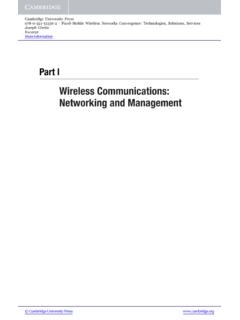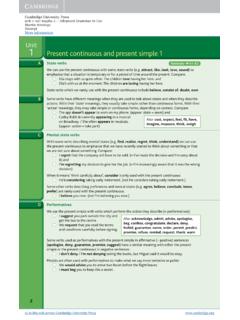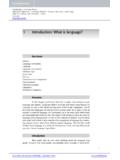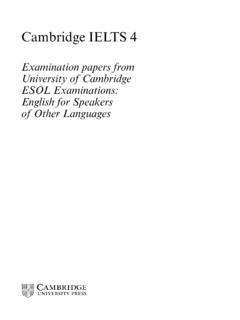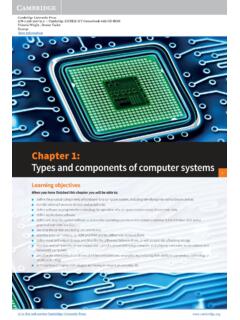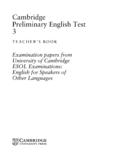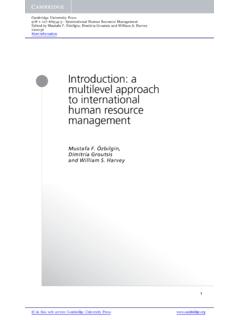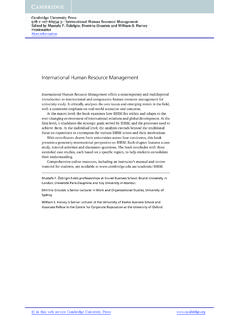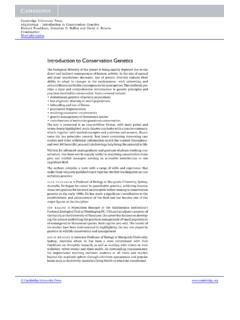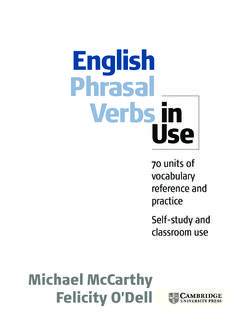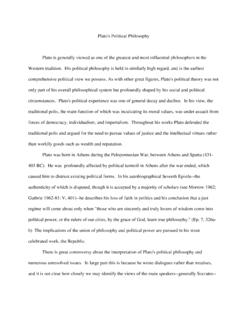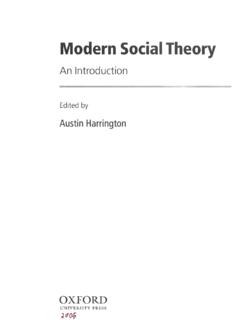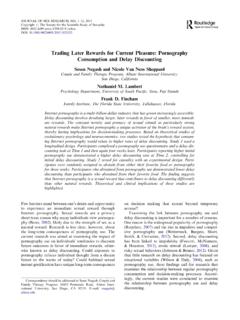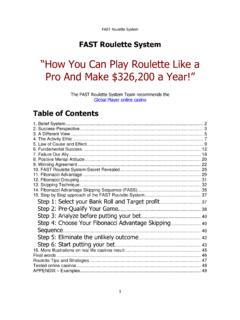Transcription of SECOND EDITION STUDY reading - Cambridge University Press
1 STUDYSECOND EDITIONEric H. Glendinning Beverly Holmstr mreadingA course in reading skills for academic purposesPUBLISHED BY THE Press SYNDICATE OF THE University OF CAMBRIDGEThe Pitt Building, Trumpington Street, Cambridge , United KingdomCAMBRIDGE University PRESSThe Edinburgh Building, Cambridge CB2 2RU, UK40 West 20th Street, New York, NY 10011 4211, USA477 Williamstown Road, Port Melbourne, VIC 3207, AustraliaRuiz de Alarc n 13, 28014 Madrid, SpainDock House, The Waterfront, Cape Town 8001, South Cambridge University Press 2004 This book is in copyright. Subject to statutory exceptionand to the provisions of relevant collective licensing agreements,no reproduction of any part may take place withoutthe written permission of Cambridge University published 2004 Printed in the United Kingdom at the University Press , CambridgeTypeface Minion 11/13pt System QuarkXpress [HMCL]
2 A catalogue record for this book is available from the British LibraryISBN 0 521 54776 8 The authors and publishers are grateful for permission to use the copyright materialsappearing in this book, as indicated in the sources and acknowledgements there are errors or omissions the publishers would be pleased to hear and to makethe appropriate correction in future Student6 Who is STUDY Readingfor? 6 What does STUDY Readingcover? 6 How does STUDY Readingwork? 6 Tothe Teacher7 Who is STUDY Readingfor? 7 What makes STUDY Readingdifferent from other readingtextbooks?
3 7 Theoretical influences 8 How is STUDY Readingorganised? 9 How can I use STUDY Readingwith my class? 9 Text Map11 PART 1 Preparing to studyUNIT 1 Getting to know your textbook14 Before you read14 Parts of a textbook14 Scanning18 Text exploration21 Discourse STUDY : Textbook structure21 Word STUDY : Words which substitute for other words21 Self-study23 Application23 UNIT 2 Choosing what to read25 Before you read25 reading and interaction27 reading with a purpose27 Prediction27 Text exploration32 Discourse STUDY : Chapter structure32 Word STUDY : Dealing with unfamiliar words32 Word STUDY .
4 Building an academic vocabulary35 Application36 ContentsContents4 PART 2 Knowing what s importantUNIT 3 The spirit of enquiry40 Before you read40 reading and interaction43 Surveying a text43 Text exploration45 Discourse STUDY : Linking words45 Self-study46 Word STUDY : Using immediate context47 Word STUDY : Collocations49 Application50 UNIT 4 The developing world52 Before you read52 reading and interaction56 reading for important points56 Text exploration61 Discourse STUDY : Signpost expressions61 Word STUDY : Building an academic vocabulary62 Application62 UNIT 5 The natural world65 Before you read65 reading and interaction66 Making inferences66 Note-taking: Linear notes67 Self-study68 Text exploration69 Discourse STUDY : Identifying text structure69 Word STUDY : Building an academic vocabulary, academic words andrelated forms71 Application72 UNIT 6 The physical world75 Before you read75 reading and interaction79 reading graphics79 Text exploration82 Discourse STUDY : Marking text structure82 Discourse STUDY : Spider notes84 Word STUDY .
5 Using the wider context, academic words and related forms85 Application88 Contents5 UNIT 7 Into the future92 Before you read92 reading and interaction94 Comparing sources94 Text exploration96 Identifying viewpoints96 Word STUDY : Word structure98 Application100 UNIT 8 The individual and society103 Before you read103 reading and interaction104 Critical reading104 Text exploration106 Discourse STUDY : Forms of argument 1106 Word STUDY : Maximisers and minimisers108 Application109 UNIT 9 Work112 Before you read112 reading and interaction114 Critical reading : Comparing viewpoints114 Text exploration118 Discourse STUDY : Forms of argument 2118 Word STUDY : 1 Emphasising and distancing120 Word STUDY : 2 Connotations121 Application121 PART 3 The tools of researchUNIT 10 reading for research124 Before you read1241 Choosing the best source1242 Locating specific information126 reading and interaction129 reading for research129 Text exploration133 Word STUDY : Choosing keywords134 Application134 Appendix136 Key142 Acknowledgements1601 UNITThis unit aims to develop the reading strategies and skills required for.
6 Esurveying a textbookrusing an indextdealing with word to know your textbookBefore you readDuring your studies, you will learn from your lecturers, your fellowstudents and from written information resources, both in print formand the written information resources you expect to use in yourcourse. Then rank your choice (1 to 9, with 1 being the mostpopular) and compare your ranking with others in your notesIndexing and abstracting databasesEncyclopaediasWebsites/e-learni ng materialsDictionariesTheses and dissertationsOther specifyA textbook can be one of your most valuable sources of the parts of a textbook is the first step to using it of a textbookStudy this list of some of the parts of a textbook.
7 Try to match theparts with the correct descriptions. When you have finished,compare your answers with your 1 Getting to know your textbook14 TASK 1 TASK 2 Parts of a textbook Descriptionsa) bibliography1 the units of the bookb) title page2 sources used by the authorc) appendix3 a list of the main topics by chapterd) preface/introduction4 a list of books, articles, etc. which provide further reading on thethemes covered in the book; usually found at the end Identify the parts of a textbook that are shown below. Thencompare your answers with those of your neighbour.
8 What is thebook about?Unit 1 Getting to know your textbook15e) acknowledgements5 an alphabetical list of topics in detail f) contents6 additional information, often for reference purposes, found at theend of the bookg) chapters7 selling points, author information, positive reviews h) references8 thanks to people who have helped with the book i) glossary9 the author s aims and the coverage of the book j) index10 a mini-dictionary of specialist terms used k) back cover11 title, author and publisher l) foreword12 a short introduction to the book written not by the author but bysomeone familiar with the author s work TASK ) The importance a brand holds for different groups of people.
9 It is a measureor indication of emotional closeness to, or distance from, a brand; it isdifferent from ) The extent to which a brand comes readily to mind ( measured by firstmentions in answer to a brand awareness question) or the most frequentlymentioned brand in connection with a set of published 1999 Admap PublicationsFarm RoadHenley-on-ThamesOxfordshire RG9 1 EJUnited Kingdom3 IQualitative Research New or Old Discipline?14 IIQualitative Research Warts & All52 IIIA Review of Qualitative Methods744 This book is a very personal effort to explain how I thinkabout human beingsand their relationships to brands, communications and the delivery of service,and hence what I doas a quantitative researcher.
10 My credentials for attemptingto do this are 30 years of would you read these parts of a textbook?1 Covers2 Title page3 Publishing details publisher, date, place of publication4 Foreword, Preface or Introduction5 Contents6 Index7 BibliographyWhen you have recorded all your answers, go on to Task this passage to find the reasons given for reading each of thetextbook parts listed in Task 4. Discuss with the others in your groupany differences between your answers to Task 4 and the reasonsgiven in the 1 Getting to know your textbook165 Lesley Thompson is an excellent quantitative researcher whom I admire.
